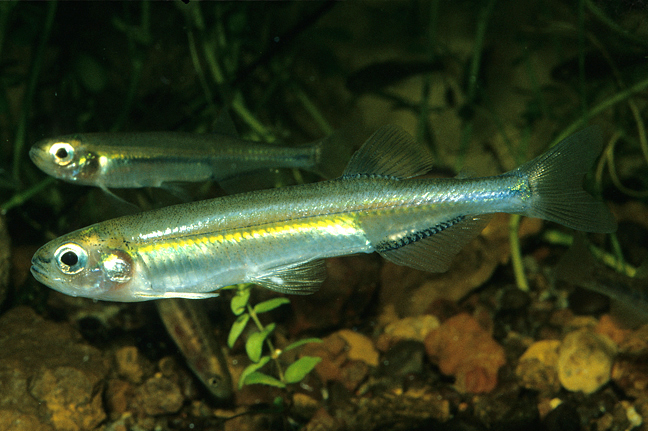Tasmanian Smelt, Retropinna tasmanica McCulloch 1920

Tasmanian Smelt, Retropinna tasmanica. Source: Rudie H. Kuiter / Aquatic Photographics. License: All rights reserved
A slender olive-green fish with a silvery belly. As adults, Tasmanian Smelt spend most of their lives at sea. During spring and summer they migrate to the lower reaches of rivers and streams to spawn, forming shoals in estuaries and freshwater. The newly hatched larvae are washed out to sea and develop in the open ocean.
Tasmanian Smelt, Retropinna tasmanica McCulloch 1920
More Info
|
Distribution |
Widespread in estuaries and the lower reaches of coastal, lowland streams. Most of the life cycle is spent in freshwater, though this species is thought to have a facultative diadromous life cycle involving upstream migration of adults from the sea prior to spawning. There is anecdotal evidence of landlocked populations within both lakes and streams. |
|
Features |
Dorsal fin 10-12; Anal fin 16-21; Pectoral fin 9-12; Gill rakers 18-23; Vertebrae 52-55; Scales in a longitudinal series 50-70. Body elongate, slender, compressed; dorsal and ventral profiles even and gradually arched; eyes large; snout pointed; gill rakers long and slender; caudal peduncle long and slender; lateral line absent. Body scales small, thin and delicate, easily dislodged; head without scales. Dorsal fin originates just in front of vent; anal fin longer than dorsal fin, highest at front; small adipose fin behind dorsal fin; caudal fin moderately forked. |
|
Size |
Maximum size about 7 cm, commonly 5-6 cm. |
|
Colour |
Olive overall with a silvery belly and largely unpigmented fins. |
|
Feeding |
Schools in lowland streams feeding at or near the surface on mosquito and caddisfly larvae, amphipods, water bugs, beetle larvae, adult flies and zooplankton. |
|
Biology |
Adults migrate from the sea into the lower reaches of coastal rivers to spawn during spring and summer. Eggs are less than 1.0mm diameter. Newly hatched larvae are carried on tides out to sea where they develop to maturity. |
|
Remarks |
Freshly caught fish emit a cucumber-like odour. |
|
Similar Species |
Most similar to Retropinna semoni but the two species do not co-occur. |
|
Etymology |
The species is named for the type locality: Tasmania. |
|
Species Citation |
Retropinna tasmanica McCulloch 1920, Records of the Australian Museum 13(2): 54, pl. 11(4) 41-71. Type locality: Huon River, Tasmania. |
|
Author |
Gomon, M.F. & Bray, D.J. 2024 |
|
Resources |
Tasmanian Smelt, Retropinna tasmanica McCulloch 1920
References
Allen 1989
Allen, G.R., Midgley, S.H. & Allen, M. 2002. Field Guide to the Freshwater Fishes of Australia. Perth : Western Australian Museum 394 pp.
Chilcott, S.J. & Humphries, P. 1996. Freshwater fish of northeast Tasmania with notes on the dwarf galaxias. Records of the Queen Victoria Museum 103: 145-149.
Freeman, R. 2019. Retropinna tasmanica. The IUCN Red List of Threatened Species 2019: e.T122902110A123382091. https://dx.doi.org/10.2305/IUCN.UK.2019-3.RLTS.T122902110A123382091.en. Accessed on 05 March 2024.
Last, P.R., Scott, E.O.G. & Talbot, F.H. 1983. Fishes of Tasmania. Hobart : Tasmanian Fisheries Development Authority 563 pp. figs.
McCulloch, A.R. 1920. Studies in Australian fishes, No. 6. Records of the Australian Museum 13(2): 41-71 figs 1-3 pls 10-14
McDowall, R.M. 1979. Fishes of the family Retropinnidae (Pisces : Salmoniformes): A taxonomic revision and synopsis. Journal of the Royal Society of New Zealand 9(1): 85-121 figs 1-11
McDowall, R.M. 1996. in McDowall, R.M. (ed.) Freshwater Fishes of South-eastern Australia. Sydney : Reed Books 247 pp.
Merrick, J.R. & Schmida, G.E. 1984. Australian Freshwater Fishes Biology and Management. Sydney : J.R. Merrick 409 pp. figs 280 col. figs.
Raadik, T.A. 2008. Family Retropinnidae. pp. 214-216 in Gomon, M.F., Bray, D.J. & Kuiter, R.H. (eds). Fishes of Australia's Southern Coast. Sydney : Reed New Holland 928 pp.
Unmack, P.J., Adams, M., Hammer, M.P., Johnson, J.B., et al. 2021. Plotting for change: an analytical framework to aid decisions on which lineages are candidate species in phylogenomic species discovery, Biological Journal of the Linnean Society 135(1): 117–137, https://doi.org/10.1093/biolinnean/blab095

